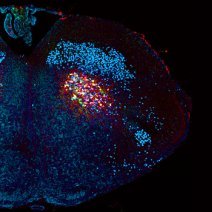A medullary centre for lapping in mice
B Dempsey, S Sungeelee, P Bokiniec, Z Chettouh, S Diem, S Autran, E R. Harrell, J F. A. Poulet, C Birchmeier, H Carey, A Genovesio, S McMullan, C Goridis, G Fortin#, J-F Brunet#
Authors :
Bowen Dempsey, Selvee Sungeelee, Phillip Bokiniec, Zoubida Chettouh, Séverine Diem, Sandra Autran, Evan R. Harrell, James F. A. Poulet, Carmen Birchmeier, Harry Carey, Auguste Genovesio, Simon McMullan, Christo Goridis, Gilles Fortin# & Jean-François Brunet#
# co-senior author
Abstract
It has long been known that orofacial movements for feeding can be triggered, coordinated, and often rhythmically organized at the level of the brainstem, without input from higher centers. We uncover two nuclei that can organize the movements for ingesting fluids in mice. These neuronal groups, IRtPhox2b and Peri5Atoh1, are marked by expression of the pan-autonomic homeobox gene Phox2b and are located, respectively, in the intermediate reticular formation of the medulla and around the motor nucleus of the trigeminal nerve. They are premotor to all jaw-opening and tongue muscles. Stimulation of either, in awake animals, opens the jaw, while IRtPhox2b alone also protracts the tongue. Moreover, stationary stimulation of IRtPhox2b entrains a rhythmic alternation of tongue protraction and retraction, synchronized with jaw opening and closing, that mimics lapping. Finally, fiber photometric recordings show that IRtPhox2b is active during volitional lapping. Our study identifies one of the subcortical nuclei underpinning a stereotyped feeding behavior.
Nat Commun. 2021 Nov 2 ;12(1):6307. doi : 10.1038/s41467-021-26275-y.


